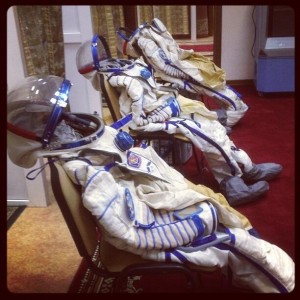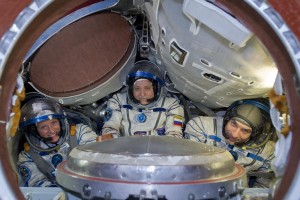 Last week was a national holiday in Russia – from 1-5 May – so Star City was closed. This meant we had to pass our last exams with a week’s break in between.
Last week was a national holiday in Russia – from 1-5 May – so Star City was closed. This meant we had to pass our last exams with a week’s break in between.
Until a few months ago, when I was part of the Soyuz TMA-07M backup crew, there were only two exams: one consists of a day-long simulation of tasks performed on the Russian part of the International Space Station, usually ending with an emergency such as a fire or decompression. The other exam is the final Soyuz exam when the whole crew dress in their space suits and get into the capsule for a simulated launch, docking and landing. This is done in one day. Both exams last about eight hours: four hours in the morning and four hours in the afternoon.
On this mission we will perform a same-day rendezvous and docking, so there is an extra exam to assess our ability to follow the procedures for our journey which will last four Earth-orbits in only six hours instead of the two days the voyage used to take while orbiting Earth 34 times. The exam in the simulator is just as long as the real flight!
exam to assess our ability to follow the procedures for our journey which will last four Earth-orbits in only six hours instead of the two days the voyage used to take while orbiting Earth 34 times. The exam in the simulator is just as long as the real flight!
The commander and myself play a fundamental role on the approach to the Space station: the commander sits in the command module while I sit in the service module along with the cargo. If we need to do a manual docking during a two-day rendezvous I will have to use a laser to measure the distance between our capsule and the Station. Usually all these phases are done automatically by computers and radar but in case of a malfunction we need to be able to switch to manual mode.
 The procedure to follow in a manual docking is that I release my seat belt and move to the service module, called Бытовой Отсек – or BO for short! Once in place I start measuring the distance between our ship and the Station using the laser. With the help of a calculator I transform the measurements into information about our speed. All this is done in coordination with the commander, it is my task to advise him when and at what level he needs to brake – by igniting the thrusters – to slow down our approach and ‘park’ near the Station at a safe distance between 50-100 metres. At this point, the capsule is perfectly still in relation to the Station.
The procedure to follow in a manual docking is that I release my seat belt and move to the service module, called Бытовой Отсек – or BO for short! Once in place I start measuring the distance between our ship and the Station using the laser. With the help of a calculator I transform the measurements into information about our speed. All this is done in coordination with the commander, it is my task to advise him when and at what level he needs to brake – by igniting the thrusters – to slow down our approach and ‘park’ near the Station at a safe distance between 50-100 metres. At this point, the capsule is perfectly still in relation to the Station.
You get the best score by respecting all safety parameters as well as keeping distance, time and fuel in mind. Last week this exam went very well as we managed to get the top score on all exercises. Up to now I managed to better my grades across the board in comparison to when I previously took the exams as backup crew!
In my spare time
As long as I am here on Earth, I try to enjoy outdoor life as much as possible: I go outside running almost every day. Exercise is very important for astronauts, once on the International Space Station astronauts need to exercise a minimum of two hours a day. I decided it was better to get into this rhythm straight away! I try to train every single day for at least two hours: running, cycling, swimming and sometimes I go to the gym to lift weights. In the rest of my spare time I study. It helps to be prepared on the theory during practical exams. Being aware of the consequences of actions and what must be done in case of a malfunction or emergency is vital. This is something all pilots do, we call it ’chair flying’. I kept up the habit of chair-flying as an astronaut, especially during these last phases of my training.
Something else I like to do when I find the time is to play the guitar – if not for the joy of others – but for my own pleasure. I try to keep in touch with all those who follow me via social media. Naturally, I spend a lot of time with the other astronauts here: we talk, we watch films in the evening or at the weekend. These are very busy days – sometimes they are so full that they overflow, but I still manage to find the time to do everything… the secret is not to sleep much!
others – but for my own pleasure. I try to keep in touch with all those who follow me via social media. Naturally, I spend a lot of time with the other astronauts here: we talk, we watch films in the evening or at the weekend. These are very busy days – sometimes they are so full that they overflow, but I still manage to find the time to do everything… the secret is not to sleep much!



Discussion: 6 comments
Ciao Luca! What do you mean by “the secret is not to sleep much”? I’m curious, beeing a medical student, about how you manage your sleep time. Do you have a number of hours per night decided by medical crew there in Star City or you’re free to do as you please?
How much do you sleep at night? Do you take any nap during the day?
Grazie mille!
Hello,
mine was more of a joke than anything else. During training we don’t have a specific amount of hours to sleep, as opposed to when we are on the ISS and it’s all planned (8hrs of sleep).
Of course, every individual is different: I find that my natural cycle includes about 7 hours of sleep. I know from experience that I can go for a long time with less, if I can get “power naps” in between.
In the end all I meant was that we are very busy even now that we are done with the exams!
Will we see the first five finger shoes on the station?
Hey Nigel,
But of course: brand new, black and red!
Ciao Luca,
Take pics! Not sure how you’ll deal with the lack of wash-ability after a few weeks though? 5finger socks too?
If you are looking for information about cbd oil for cats, then you’ve come to the
right location. Here I will inform you about the nonprofit
organization”The Cat Care Association” in Glendale, California.
They’re one of many businesses in the United States that produce and supply
top quality pet products like pet dyes, pet sprays, as well as other products for your cat.
I received my information about CBD for cats . Here’s what I discovered.